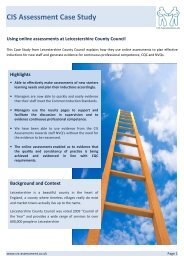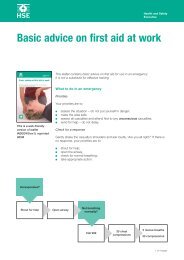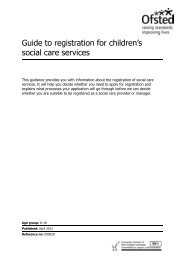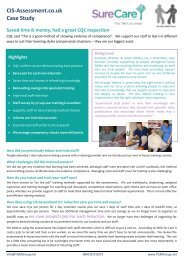Standard 8 Health and safety in an adult social care setting
Standard 8 Health and safety in an adult social care setting
Standard 8 Health and safety in an adult social care setting
Create successful ePaper yourself
Turn your PDF publications into a flip-book with our unique Google optimized e-Paper software.
CIS Assessment Induction Workbook – Eight<br />
7.5 Be aware of pr<strong>in</strong>ciples of safe h<strong><strong>an</strong>d</strong>l<strong>in</strong>g of <strong>in</strong>fected or soiled l<strong>in</strong>en <strong><strong>an</strong>d</strong> cl<strong>in</strong>ical<br />
waste<br />
The Hazardous Waste Regulations 2005 sets out how other types of waste should be<br />
dealt with. Cl<strong>in</strong>ical waste if <strong>an</strong>yth<strong>in</strong>g that consists of the follow<strong>in</strong>g:<br />
Hum<strong>an</strong> <strong><strong>an</strong>d</strong> <strong>an</strong>imal waste (faeces), <strong>in</strong>cont<strong>in</strong>ence pads, catheter <strong><strong>an</strong>d</strong> stoma bags,<br />
nappies, s<strong>an</strong>itary waste, nasal secretions, blood, condoms, swabs, dress<strong>in</strong>gs, plasters,<br />
ur<strong>in</strong>e, vomit <strong><strong>an</strong>d</strong> soiled hum<strong>an</strong> bedd<strong>in</strong>g from a non-<strong>in</strong>fectious source.<br />
Animal hygiene wastes (<strong>an</strong>imal bedd<strong>in</strong>g, dog faeces).<br />
Wastes from other health<strong>care</strong> related activities, for example, wastes<br />
from body pierc<strong>in</strong>g, the application of tattoos, syr<strong>in</strong>ges, needles or<br />
other sharp <strong>in</strong>struments<br />
Procedures to prevent contam<strong>in</strong>ation:<br />
Soiled l<strong>in</strong>en must be washed <strong>in</strong> <strong>an</strong> automatic wash<strong>in</strong>g mach<strong>in</strong>e at a temperature of at<br />
least 71 degrees for a m<strong>in</strong>imum of 3 m<strong>in</strong>utes or 65 degrees for a m<strong>in</strong>imum of 10<br />
m<strong>in</strong>utes.<br />
Where laundry is sent to <strong>an</strong>other department for process<strong>in</strong>g, it should be segregated <strong>in</strong><br />
colour coded l<strong>in</strong>en bags. Laundry bags should not be overfilled <strong><strong>an</strong>d</strong> should be properly<br />
sealed before tr<strong>an</strong>sport<strong>in</strong>g.<br />
Laundry must be fully dried before re-use to assist <strong>in</strong> remov<strong>in</strong>g micro-org<strong>an</strong>isms<br />
8. Promot<strong>in</strong>g fire <strong>safety</strong> <strong>in</strong> the work sett<strong>in</strong>g<br />
8.1 Underst<strong><strong>an</strong>d</strong> practices that prevent fires from:<br />
Start<strong>in</strong>g<br />
Spread<strong>in</strong>g<br />
In order for a fire to start, 3 th<strong>in</strong>gs are needed:<br />
Heat or a source of ignition<br />
Oxygen<br />
Fuel<br />
F<strong>in</strong>d out if your employer has a laundry policy.<br />
You should also take time to f<strong>in</strong>d <strong><strong>an</strong>d</strong> read<br />
The Hazardous Waste Regulations 2005<br />
A copy c<strong>an</strong> be found on the HSE’s website<br />
+ +<br />
This is called a fire tri<strong>an</strong>gle. A fire c<strong>an</strong>not start if one of these elements is miss<strong>in</strong>g.<br />
Page 21 of 46
















